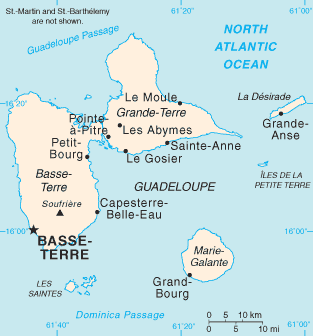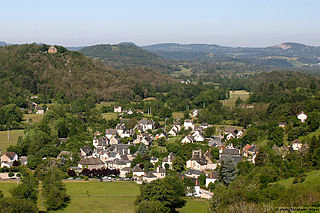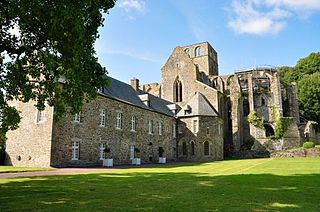Notre Dame, French for "Our Lady", a title of Mary, mother of Jesus, most commonly refers to:

The term Black Madonna or Black Virgin tends to refer to statues or paintings in Western Christendom of the Blessed Virgin Mary and the Infant Jesus, where both figures are depicted with dark skin. Examples of the Black Madonna can be found both in Catholic and Orthodox countries.

Lorient is a town (commune) and seaport in the Morbihan department of Brittany in western France.

Fécamp is a commune in the Seine-Maritime department in the Normandy region in north-western France.

La Désirade is an island in the French West Indies, in the Lesser Antilles of the Caribbean. It forms part of Guadeloupe, an overseas region of France.

Flamboyant is a form of late Gothic architecture that developed in Europe in the Late Middle Ages and Renaissance, from around 1375 to the mid-16th century. It is characterized by double curves forming flame-like shapes in the bar-tracery, which give the style its name; by the multiplication of ornamental ribs in the vaults; and by the use of the arch in accolade. Ribs in Flamboyant tracery are recognizable by their flowing forms, which are influenced by the earlier curvilinear tracery of the Second Gothic styles. Very tall and narrow pointed arches and gables, particularly double-curved ogee arches, are common in buildings of the Flamboyant style. In most regions of Europe, Late Gothic styles like Flamboyant replaced the earlier Rayonnant style and other early variations.

The Notre-Dame-de-Bon-Secours Chapel is a church in the district of Old Montreal in Montreal, Quebec. One of the oldest churches in Montreal, it was built in 1771 over the ruins of an earlier chapel. The church is located at 400 Saint Paul Street East at Bonsecours Street, just north of the Bonsecours Market in the borough of Ville-Marie.

Antignac is a commune in the Cantal department in the Auvergne region of south-central France.

Opened on May 24, 1998, the Marguerite Bourgeoys Museum is located on the shores of the Saint Lawrence River in the historic centre of Old Montreal in Montreal, Quebec, Canada. Exhibits focus on Marguerite Bourgeoys, Montreal's first teacher and founder of the Notre-Dame-de-Bon-Secours Chapel, who lived during the 17th century. Displays highlight her accomplishments that recall the great courage of the early colonists who built Montreal.

UNESCO designated the Routes of Santiago de Compostela in France as a World Heritage Site in December 1998. The routes pass through the following regions of France: Aquitaine, Auvergne, Basse-Normandie, Bourgogne, Centre, Champagne-Ardenne, Ile-de-France, Languedoc-Roussillon, Limousin, Midi-Pyrénées, Picardie, Poitou-Charentes, and Provence-Alpes-Côte d'Azur. UNESCO cites the routes' role in "religious and cultural exchange", the development of "specialized edifices" along the routes, and their "exceptional witness to the power and influence of Christian faith among people of all classes and countries in Europe during the Middle Ages".

Hambye abbey is a Benedictine medieval monastery located in the countryside of Normandy. It lies in the valley of Sienne in a rural preserved environment. Today it is on the territory of the municipality of Hambye.
This is a listing of some of the works of Jean Fréour.

The Chartres pilgrimage, also known in French as the pèlerinage de Chrétienté, is an annual pilgrimage from Notre-Dame de Paris to Notre-Dame de Chartres occurring around the Christian feast of Pentecost, organized by Notre-Dame de Chrétienté, a Catholic lay non-profit organization based in Versailles, France. Although the pilgrimage has existed since 1983, the organisation was not founded until 2000.

Bernay Abbey was a Benedictine abbey in Bernay, Eure, France. The designers of its abbey church were ahead of their time, making it one of the first examples of Romanesque architecture in Normandy. It shows the early evolution of that style, its decorative elements and its building techniques.
Guillaume Pontifs was a 15th-century French master builder.

Regnobert of Bayeux, Regnobertus in Latin, also transcribed in Renobert, Rénobert, Rennobert or Raimbert, was the twelfth bishop of Bayeux and a Saint of the Roman Catholic Church in the 7th century.

The Lefebvre family was a family of famous organ builders in 17th and 18th century Normandy, France. The last name has occasionally been written as Lefèvre.

Edmond Clément Marie Duthoit was a French 19th-century architect, originating from Amiens. He was the eldest son of Aimé Duthoit, the nephew of Louis Duthoit, both picard designers and sculptors, and the father of Louis Duthoit.

The Church of the Saintes Maries de la Mer is a Romanesque fortified church built in the 9th century in Saintes-Maries-de-la-Mer in Camargue, Bouches-du-Rhône, Provence. Dedicated to Mary, mother of Jesus and to The Three Marys, it is the subject of annual Roma pilgrimage. Since 1840, it has been classified as a French Historical Monument.
















